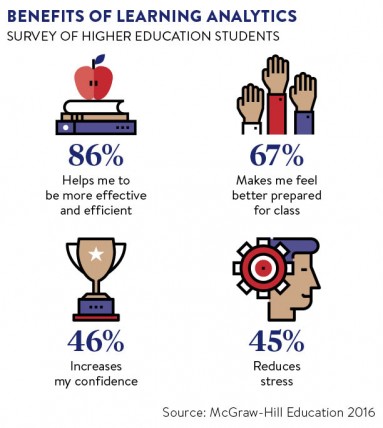It is among the most promising technologies, yet remains rarely used in business. Learning analytics, a pioneering system used in a number of universities to transform tuition, is stuck at the periphery of managers’ strategic vision, pushed out by the dominant efficiency and customer targeting strategies.
Businesses are missing out. Experts say learning analytics technology would enable them to make development programmes consistently deliver. Staff would learn more quickly and efficiently, and achieve better outcomes, because their engagement and learning could be measured, understood and responded to.
Organisations’ closed viewpoint is to some degree understandable, given that they cannot see others using the technology. But in their fear and distraction, companies are overlooking just how effective learning analytics is. It pulls together data on what online training modules employees are looking at, how well they are doing, where they are stuck, how long they spend studying and what the outcomes are, enabling effective course changes.
“Previously, learning and development groups paid for professional training and just hoped it worked,” says Lisa Barrett, managing director at digital learning firm Avado. “Now they can see if people are watching videos to the end, if they are guessing on assessments, if it’s all too easy and what’s working.”
Make learning visible
With so much learning in business being unstructured, it is difficult to view and assess. “The first potential of analytics is to make learning visible, so it can be made more effective,” explains Graham Attwell, director of educational research organisation Pontydysgu.
 The resulting analysis highlights the training that is delivering the best outputs for individuals’ capabilities. Will Chadwick, UK vice president at Tata Interactive Systems, explains that it enables “the delivery of personalised bite-sized learning, to narrow individual capability gaps”. Organisations can also set much fairer performance targets based on real abilities.
The resulting analysis highlights the training that is delivering the best outputs for individuals’ capabilities. Will Chadwick, UK vice president at Tata Interactive Systems, explains that it enables “the delivery of personalised bite-sized learning, to narrow individual capability gaps”. Organisations can also set much fairer performance targets based on real abilities.
“I strongly believe this will change the approach to learning and the focus will shift to how the top performers can be stretched rather than dragging up the performance of the bottom quintile,” he adds.
Such radical change in learning and development means organisations will be better prepared for the future environment. Prithvi Shergill, chief human resources officer at HCL Technologies, says: “We will need to shift from an orientation of prescription to an orientation of prediction, so we can ensure people and teams are future-ready.” Analytics are crucial to preparing for this new world.
Several large organisations have grasped the potential and are ahead of the curve in their adoption. The International Olympic Committee has been among those working with Avado to offer learning to athletes that fits around their training. HSBC, meanwhile, has been providing more engaging and responsive digital learning to its 1,000 marketing employees, resulting in improved measurement and performance, and more effective learning groups.
Fast food retailer KFC is rolling out its own analytics to understand employee training across 825 UK restaurants. Newspaper the Financial Times uses the technology to quicken career development and digital-skills knowledge, while marketing agency iProspect is improving training in the interests of staff satisfaction and retention.
The industries most likely to adopt the technology are those closest to consumers, given their existing appreciation for analytics in customer targeting. “We see a lot of interest in fast-moving consumer sectors such as retail, telecoms, high street banking and insurance,” says Ms Barrett at Avado.
Arrival of learning analytics programmes remains an inevitability as organisations develop a data-driven culture
It is important not to overstate take-up, which is held back in most companies by several factors. Alan Duncan, a research director at analyst house Gartner, warns that many firms still “don’t understand what they actually need”, and time spent working out these aims simply has to precede their purchasing of tools.
There is also some nervousness among learning and development departments of the sudden accountability they and their employees face. “There’s a degree of sensitivity, but there’s also a sense that HR, learning and development need to get smarter to changing demands,” says Mr Duncan.
[embed_related]
Whatever tack businesses take, the arrival of learning analytics programmes remains an inevitability as organisations develop a data-driven culture. Such programmes will be enabled and powered by chief data officers, those new corporate chiefs responsible for the collation of, and results from, massive amounts of information.
But employees might resist the change. They are certainly torn between a negative and a positive concept: the danger of their development being closely examined, yet the potential for training that is responsive to their exact needs. In a recent, small public-sector experiment in the EU, staff reportedly asked for more analytics in the interest of better learning, while it was their managers who were nervous and feared the analysis would force them to invest in better training.
There is a final, understandable concern that is holding back the adoption of learning analytics – data privacy. No one wants to be identified for slow development at work. The situation can be maturely handled, however. “To some degree, having transparency here is a good thing. It can be used to provide constructive feedback,” says Mr Duncan. “Of course, companies could use it for ill, to target employees, but that would be a culture and data-handling problem rather than an issue with the information itself.”
In making learning analytics work, businesses face cultural and technical challenges. Many are also distracted by other pressing objectives. There is, however, no denying that companies are overlooking the enormous potential to have a truly functional, effective workforce. To continue doing so would be a grave mistake.
Make learning visible






